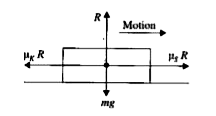The co-efficient of static & kinetic friction are 0.6 & 0.3. The minimum horizontal force required to start the motion is applied and if it is continued, the distance travelled by the body in 4 sec is (g=10ms−2)
6m
24 m
2.4 m
5m
The correct Answer is:B
Topper's Solved these Questions
- BOOK - AAKASH SERIESCHAPTER - LAWS OF MOTIONEXERCISE - EXERCISE - II136videos
LAWS OF MOTION
- BOOK - AAKASH SERIESCHAPTER - KINETIC THEORY OF GASESEXERCISE - Practice Exercise15videos
KINETIC THEORY OF GASES
- BOOK - AAKASH SERIESCHAPTER - MECHANICAL PROPERTIES OF FLUIDS EXERCISE - EXERCISE-343videos
MECHANICAL PROPERTIES OF FLUIDS
Similar Questions
A block of mass 2 kg is on a horizontal surface. The coefficient of static & kinetic frictions are 0.6 & 0.2 The minimum horizontal force required to start the motion is applied and if it is continued, the velocity acquired by the body at the end of the 2nd second is (g=10ms2)
View SolutionIf the mass of A=10 kg, coefficient of static friction=0.22, coefficient of kinetic friction=0.2, then minimum mass of B to start motion is
 View Solution
View Solution
Knowledge Check
- Question 1 - Select One
The coefficients of static and dynamic friction are 0.7 and 0.4. The minimum force required to create motion is applied on a body and if it is further continued, the acceleration attained by the body in ms−2 is (g=10m/s−2)
A7B4C3DZero - Question 2 - Select One
The coefficients of static and dynamic friction are 0.7 and 0.4 The minimum force required to create motion is applied on a body and if it is further continued the acceleration attained by the body in ms−2 is (g=10m/s2) .
A7B4C3DZero - Question 3 - Select One
A body of mass 2 kg is placed on a horizontal surface having coefficient of kinetic friction 0.4 and limiting coefficient of static friction 0.5. If a horizontal force 2.5 N is applied on the body, the frictional force acting on the body will be (Take, g=10ms2)
A8 NB10 NC20 ND2.5 N
If the mass of A=10 kg, coefficient of static friction=0.22, coefficient of kinetic friction=0.2, then minimum mass of B to start motion is
 View Solution
View SolutionIf the mass of A=10 kg, coefficient of static friction=0.22, coefficient of kinetic friction=0.2, then minimum mass of B to start motion is
 View Solution
View SolutionIf the mass of the block A = 10 kg and the coefficient of static and kinetic friction is 0.2, then the mass of block B to start the motion is
 View Solution
View SolutionA horizontal force just sufficient to move a body of mass 4kg lying on a rought horizontal surface is applied on it .The coefficient of static and kinetic friction the body and the surface are 0.8and0.6 respectively If the force contines to act even after the block has started moving the acceleration of the block in ms−2 is (g=10ms−2)
View SolutionFor a body on a horizontal surface, coefficients of static and kinetic frictions are 0.4 and 0.2 respectively. When the body is in uniform motion on the surface, a horizontal force equal in magnitude to limiting friction is applied on it. The acceleration produced is
 View Solution
View Solution
